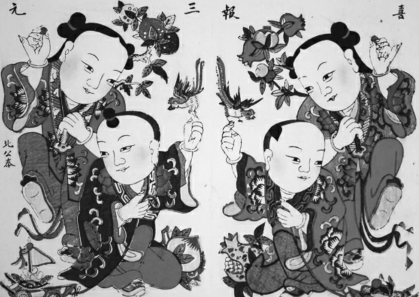
A Yangjiabu New Year painting features four children ushering in a prosperous happy New Year.[JU CHUANJIANG/CHINA DAILY]
A typical painting once widespread during the Ming Dynasty, for example, portrays the story of Emperor Zhu Yuanzhang, founder of the dynasty, showing his ministers how to plow the fields. The picture was trying to persuade the emperor to stop his despotic rule and develop production.
"Yangjiabu painting stands out with its rich use of bright color, rough lines, exaggerated images, and full composition. It is pure and down-to-earth, and it is especially favored among the Chinese public," says Wang.
There is an old saying that during the Qing Dynasty (1644-1911), each family in Yangjiabu had a painting workshop, and everybody was good at the handicraft, he says.
The custom is particularly popular in the countryside, where colorful paintings remain the dominant decorations on doors, windows, walls and even on wardrobes and stoves throughout the year.
"However, with the invasion of modern production methods, traditional printing techniques have been challenged and few young people have enough patience to learn the craft," says Zhang Dianying, a local well-known folk artist and vice-president of China Woodprint New Year Painting Association.
"Making a Yangjiabu New Year painting generally requires at least 10 steps, ranging from sketching outlines, engraving the woodblock, printing and painting to mounting. All of them have to be completed by hand," the 78-year-old explains.
"The most difficult step is the carving. One wooden board needs to be engraved for one kind of color. To master such a skill requires years of experience," says Zhang, whose palms show signs of wear, dyed yellow with thick calluses.
To show the versatility of the art form, Zhang spent four years engraving a total of 531 woodblocks and creating a 32-meter-long painting. Named The Happiness of Chinese Farmers, it vividly depicts more than 1,000 characters and 100 scenes. It is said to be the nation's largest woodblock-printed painting and is part of the collection of the National Museum of China.
"My work is a piece of art, which cannot be achieved by machines," he says with great pride.
Meanwhile, Zhang's much-younger peers at a local culture and art company are committed to breathing new life into the traditional art form.
"We are attempting to renew the motifs and forms of traditional Yangjiabu New Year paintings through combining diversified art styles, to cater to modern tastes," says 39-year-old Yang Zhibin, an artist with Weifang Fengtai Culture and Art Co.
One of his bold inventions is combining the traditional craft with the styles of modern oil and watercolor painting, bringing a modern touch to the folk art.
The local government has also taken a range of measures to popularize the art in recent years. A 146,000-square-meter folk art garden has been established in Yangjiabu, where tourists can see not only rural people's residences with touches of the Ming and Qing dynasties, but also see how New Year paintings are made.
"We invite tourists to come and buy our paintings. The number of visitors has grown to 800,000 annually from 20,000 in the 1990s," says Yang Gaozhi, head of the Yangjiabu village.
Professional courses have been set up in several local primary and middle schools to train new artists and foster young people's interest in the traditional art form.
We recommend:
